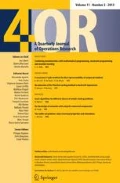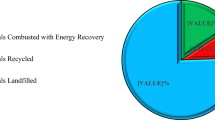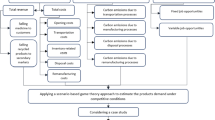Abstract
This paper investigates the coordination problem of a supply chain (SC) composed of a manufacturer exhibiting corporate social responsibility (CSR) and a retailer faced with random demand. The random demand is made up of the multiplication of price-dependent demand and random demand factor (RDF), plus the CSR-dependent demand. The centralized decision problem of the SC is an extension of the existing price setting newsvendor problem (PSNP). It is found that the sufficient condition for the quasi-concavity of expected profit (EP) on PSNP can not ensure the quasi-concavity of EP of the SC. Then, the concavity condition of EP related to the CSR effect factor is presented in the case of uniformly distributed RDF and linear demand in price, and the concavity of EP is proven under centralized decision. For decentralized decision under manufacturer’s Stackelberg game, the manufacturer determines wholesale price and its CSR investment, and then the retailer decides the order quantity and the retail price. The standard revenue-sharing (RS) contract is found not able to coordinate the SC, so a modified RS (MRS) contract is proposed to coordinate the SC. Finally, numerical examples illustrate the validity of the theoretical analysis and the coordination effectiveness of the MRS contract via Matlab.



Similar content being viewed by others
References
Ageron B, Gunasekaran A, Spalanzani A (2012) Sustainable supply management: an empirical study. Int J Prod Econ 140:168–182
Amaeshi KM, Osuji OK, Nnodim P (2008) Corporate social responsibility in supply chains of global brands: a boundaryless responsibility? Clarifications, exceptions and implications. J Bus Ethics 81:223–234
Arcelus FJ, Kumar S, Srinivasan G (2011) Channel coordination with manufacturer’s return policies within a newsvendor framework. 4OR A Q J Oper Res 9:279–297
Cachon GP, Lariviere MA (2005) Supply chain coordination with revenue-sharing contracts: strengths and limitations. Manag Sci 51:30–44
Carter CR, Jennings MM (2002) Social responsibility and supply chain relationships. Transp Res Part E Logist Transp Rev 38:37–52
Cruz JM (2008) Dynamics of supply chain networks with corporate social responsibility through integrated environmental decision-making. Eur J Oper Res 184:1005–1031
Cruz JM, Wakolbinger T (2008) Multiperiod effects of corporate social responsibility on supply chain networks, transaction costs, emissions, and risk. Int J Prod Econ 116:61–74
He Y, Zhao X (2012) Coordination in multi-echelon supply chain under supply and demand uncertainty. Int J Prod Econ 139:106–115
Hsueh CF (2014) Improving corporate social responsibility in a supply chain through a new revenue sharing contract. Int J Prod Econ 151:214–222
Hsueh CF (2015) A bilevel programming model for corporate social responsibility collaboration in sustainable supply chain management. Transp Res Part E Logist Transp Rev 73:84–95
Hsueh CF, Chang M-S (2008) Equilibrium analysis and corporate social responsibility for supply chain integration. Eur J Oper Res 190:116–129
Kocabiyikoglu A, Popescu I (2011) An elasticity approach to the newsvendor with price-sensitive demand. Oper Res 59:301–312
Lu Y, Simchic-Levi D (2013) On the unimodality of the profit function of the pricing newsvendor. Prod Oper Manag 22:615–625
Luo S, Sethi SP, Shi R (2016) On the optimality conditions of a price-setting newsvendor problem. Oper Res Lett 44:697–701
Modak NM, Panda S, Sana SS, Basu M (2014) Corporate social responsibility, coordination and profit distribution in a dual-channel supply chain. Pac Sci Rev 16:235–249
Modak NM, Panda S, Sana SS (2015) Pricing policy and coordination for a two-layer supply chain of duopolistic retailers and socially responsible manufacturer. Int J Logist Res Appl 19:487–508
Modak NM, Panda S, Mishra R, Sana S (2016) A three-layer supply chain coordination in socially responsible distribution system. Tékhne 14:75–87
Ni D, Li KW (2012) A game-theoretic analysis of social responsibility conduct in two-echelon supply chains. Int J Prod Econ 138:303–313
Ni D, Li KW, Tang X (2010) Social responsibility allocation in two-echelon supply chains: insights from wholesale price contracts. Eur J Oper Res 207:1269–1279
Panda S (2014) Coordination of a socially responsible supply chain using revenue sharing contract. Transp Res Part E Logist Transp Rev 67:92–104
Panda S, Modak NM (2016) Exploring the effects of social responsibility on coordination and profit division in a supply chain. J Clean Prod 139:25–40
Panda S, Modak NM, Basu M (2014) Disposal cost sharing and bargaining for coordination and profit division in a three-echelon supply chain International. J Manag Sci Eng Manag 9:276–285
Panda S, Modak NM, Basu M, Goyal S (2015a) Channel coordination and profit distribution in a social responsible three-layer supply chain. Int J Prod Econ 168:224–233
Panda S, Modak NM, Sana SS, Basu M (2015b) Pricing and replenishment policies in dual-channel supply chain under continuous unit cost decrease. Appl Math Comput 256:913–929
Panda S, Modak NM, Pradhan D (2016) Corporate social responsibility, channel coordination and profit division in a two-echelon supply chain. Int J Manag Sci Eng Manag 11:22–33
Panda S, Modak NM, Cárdenas-Barrón LE (2017) Coordinating a socially responsible closed-loop supply chain with product recycling. Int J Prod Econ 188:11–21
Petruzzi NC, Dada M (1999) Pricing and the newsvendor problem: a review with extensions. Oper Res 47:183–194
Raza SA (2014) A distribution free approach to newsvendor problem with pricing. 4OR A Q J Oper Res 12:335–358
Tsay A (1999) Quantity–flexibility contract and supplier–customer incentives. Manag Sci 45:1339–1358
Wang Y, Jiang L, Shen Z-J (2004) Channel performance under consignment contract with revenue sharing. Manag Sci 50:34–47
Wu CH (2016) Collaboration and sharing mechanisms in improving corporate social responsibility. Cent Euro J Oper Res 24:681–707
Xu X, Cai X, Chen Y (2011) Unimodality of price-setting newsvendor’s objective function with multiplicative demand and its applications. Int J Prod Econ 133:653–661
Yao L, Chen YF, Yan H (2006) The newsvendor problem with pricing: extensions. Int J Manag Sci Eng Manag 1:3–16
Zhao X, Wu F (2011) Coordination of agri-food chain with revenue-sharing contract under stochastic output and stochastic demand. Asia Pac J Oper Res 28:487–510
Acknowledgements
The authors gratefully acknowledge the support by the National Science Foundation of China (NSFC) under Grant No. 71403114. This study was also supported by China Special Fund for Grain-scientific Research in the Public Interest under Grant No. 201513004. The author also appreciates the support by Priority Academic Program Development of Jiangsu Higher Education Institutions and the support by Collaborative Innovation Center of Modern Grain Circulation and Safety, Nanjing University of Finance and Economics.
Author information
Authors and Affiliations
Corresponding author
Appendixes
Appendixes
1.1 A. Proof of Lemma 2
From the results of PSNP in Yao et al. (2006), we know that
when there is no CSR in the SC. Comparing \( \pi ^{o}(p)\) with \(\pi ^{c}(p)\) in Eq. (10), we have \(\pi ^{c}(p)=\pi ^{o}(p)+K^{\mathrm {2}}(p-c)^{2}/4 \), thus \( \partial ^{2}\pi ^{c}/\partial p^{2}=\partial ^{2}\pi ^{o}/\partial p^{2}+K^{2}/2 \). Because of
when \(p = c \) so that \(\rho = 0\), we have \(\partial \pi ^{c}/\partial p|_{p=c} =d(c)A> 0\). When \( p={\overline{p}}\) so that \(d(p)= 0\), we have
Note that \(d^{\prime }({\overline{p}})<0 \) under the condition that d(p) has IPE, and therefore \({\overline{p}} d^{\prime }({\overline{p}} )\int \nolimits _A^{F^{-1}(\rho )} {xf(x)dx} <0 \). Because \(\partial \pi ^{c}(p)\) is continuous function w.r.t. p, only if
there exist \( \partial \pi ^{c}/\partial p=0\) in the range \( [c,{\overline{p}} ] \). To ensure \(\partial \pi ^{c}(p)\) being concave w.r.t p, we need \(\partial ^{2}\pi ^{c}/\partial p^{2}<0 \). In light of Lemma 1, we know that \(\partial ^{2}\pi ^{o}/\partial p^{2}<0 \) and \(\partial ^{2}\pi ^{o}/\partial p^{2}|_{p=p^{c}} <0 \). Note that \(\partial ^{2}\pi ^{c}/\partial p^{2}=\partial ^{2}\pi ^{o}/\partial p^{2}+K^{2}/2\) when \(p = p^{c} \). If \(K^{2}/2<\left| {\partial ^{2}\pi ^{o}/\partial p^{2}} \right| _{p=p^{c}}\), then \(\partial ^{2}\pi ^{c}/\partial p^{2}<0 \), where \(p^{c}\) is the optimal price satisfying \(\partial \pi ^{c}/\partial p=0\). Hence, we have Lemma 2.
1.2 B. Proof of Theorem 1
First, we show that there exists a p in the range \([c_m + c_r ,{\overline{p}}]\) satisfying \(\partial \pi ^{c}(p)/\partial p=0\) if \(K^{2}<2bA\). The expression of \(\partial \pi ^{c}(p)/\partial p\) can be derived from Eq. (11) and is shown as the left-hand side in Eq. (12). From Eq. (12), we know that \(\rho = 0\) when \(p = c\) and then \(\partial \pi ^{c}(p)/\partial p|_{p=c} =(a-bc)A>0\). When \(p={\overline{p}}, d({\overline{p}})=0 \), i.e., \(a-b{\overline{p}} =0 \) and \(\rho \) reaches it maximum. Let’s denote maximal \(\rho \) by \( \bar{{\rho }}(0<\bar{{\rho }}< 1)\). Then,
It is clear that \(\partial \pi ^{c}(p)/\partial p|_{p=\bar{{p}}}<0 \) if \((K^{2}/2-bA)-b\bar{{\rho }}N/2<0\). Due to \(\bar{{\rho }}>0 , \partial \pi ^{c}(p)/\partial p|_{p=\bar{{p}}} <0 \) if \((K^{2}/2-bA)<0\), i.e., \(K^{2}<2bA\). Since \(\partial \pi ^{c}(p)/\partial p\) is continuous w.r.t. p, there must exist a solution of \(\partial \pi ^{c}(p)/\partial p=0\) in the range \([c_m \hbox {+}c_r ,{\overline{p}} ]\).
Below, we show that there exists a unique p maximizing \(\pi ^{c}(p)\); in another words, \(\pi ^{c}(p)\) is strictly concave w.r.t p, if \(b>a(B-A)/(cB)\). From the expression shown on left-hand side in Eq. (12), we have \(\partial ^{2}\pi ^{c}(p)/\partial p^{2}=K^{2}/2+(a-bp)Nc^{2}/p^{3}-b[N\rho ^{2}+2A\rho +2c(N\rho +A)/p]\). Note that \(N\rho ^{2}+2A\rho +2c(N\rho +A)/p=\rho (N\rho +A)+\frac{c}{p}(N\rho +A)+A\rho +\frac{c}{p}(N\rho +A)N\rho +A+A\rho +(1-\rho )(N\rho +A)=-N(\rho -1)^{2}+A+B\). Then, we have \(\partial ^{2}\pi ^{c}(p)/\partial p^{2}=K^{2}/2+(a-bp)Nc^{2}/p^{3}+bN(\rho -1)^{2}-bA-bB\). Since the optimal price \(p > c\) and \(1> \rho > 0,\partial ^{2}\pi ^{c}(p)/\partial p^{2}<=K^{2}/2+(a-bc)N/c+bN-bA-bB=(K^{2}/2-bA)+(aN/c-bB)\). Because of \(K^{2}/2-bA< 0\), we have \(\partial ^{2}\pi ^{c}(p)/\partial p^{2}<0\) if \(aN/c-bB\le 0\), i.e., \(b\ge a(B-A)/(cB)\). In summary, \(\pi ^{c}(p)\) is strictly concave w.r.t p if \(K^{2}<2bA\) and \( b\ge a(B-A)/(cB)\). According to the first-order conditions, we know that the optimal price \(p^{c}\) is the solution of \(\partial \pi ^{c}(p^{c})/\partial p^{c}=0\), i.e., \(p^{c}\) is determined by Eq. (12).
1.3 C. Proof of Theorem 4
Since the manufacturer fist moves in manufacturer’s Stackelberg game under standard RS contract, let’s consider the optimal CSR investment y determined by the manufacturer. Under given retial price p and order quantity \(q^{{ rs}}\) that will be determined by the retailer in the later, we have \(\pi _m^{{ rs}} =(1-\phi ){ pE}[\min (q^{{ rs}},D)]-(c_m -\omega )q^{{ rs}}-y \), and then the optimal CSR investment is \(y^{{ rs}} =[K_m ((1-\phi )p+\omega ^{{ rs}}-c_m )/2]^{2}\) using the first-order condition \(\partial \pi _m^{{ rs}} /\partial y=0\). From Proposition 3, we know that the optimal CSR investment under centralized decision is \(y^c =[K(p-c_m -c_r )/2]^{2}\). Under channel coordination, \(y^{{ rs}} =y^c\) and then \((1-\phi )p+\omega ^{{ rs}}-c_m =p-c_m -c_r\), i.e., \(\omega ^{{ rs}}=\phi p-c_r\).
For the retailer, we have \(\pi _r^d =\phi { pE}[\min (q,D)]-(\omega +c_r )q\), and then the optimal order quantity is \(q^{{ rs}}=F^{-1}[(\phi p-\omega ^{{ rs}}-c_r )/(\phi p)](a-bp)+K\sqrt{y^{{ rs}}}\) given \(y^{{ rs}}\) and \(\omega ^{{ rs}}\) announced by the manufacturer. From Proposition 2, we know that the optimal order quantity under centralized decision is \(q^{c}=F^{-1}[(p-\omega ^{d}-c_r )/p](a-bp)+K\sqrt{y^c}\). Under channel coordination, \(q^{{ rs}} =q^c\) and then \((\phi p-\omega ^{d}-c_r )/(\phi p)=(p-c_m -c_r )/p\), i.e., \(\omega ^{{ rs}}=\phi (c_m +c_r )-c_r \).
To satisfy \(y^{{ rs}} =y^c\) and \(q^{{ rs}} =q^c\), we need \(\phi p-c_r =\phi (c_m +c_r )-c_r\), i.e., \(p=c_m +c_r\). Note that \(p^{c}>c=c_m +c_r\), which contradicts with \(p=c_m +c_r\). Hence, standard RS is not able to coordinate the SC.
1.4 D. Proof of Theorem 5
Substituting \(\omega =\phi (c_m +c_r )-c_r\) into Eq. (17), we have \([(1-\phi )p+\omega ^{{ rs}}-c_m ]/(1-\phi ) = p-c_m -c_r\) and then \(y^{{ rs}} =[\frac{K}{2}(p-c_m -c_r ]^{2}\). Compared Eq. (9) in Proposition 3 with \(y^{{ rs}} =[\frac{K}{2}(p-c_m -c_r ]^{2}\), it is cleat that \(y^{{ rs}}=y^{c}\). Substituting \(\omega =\phi (c_m +c_r)-c_r\) into Eq. (16), we have \((\phi p-\omega ^{{ rs}}-c_r ) /(\phi p)=(p-c_m -c_r) /p\) and then \(q^{{ rs}}=F^{-1}[(p-c_m -c_r )/p]d(p)+K\sqrt{y^{{ ys}}}\). Comparing Eq. (8) in Proposition 2 with \(q^{{ rs}}=F^{-1}[(p-c_m -c_r )/p]d(p)+K\sqrt{y^{{ ys}}}\), we have \(q^{{ rs}}=q^{c}\) owing to \(y^{{ rs}}=y^{c}\). Substituting \(\omega =\phi (c_m +c_r )-c_r\) into Eq. (18), Eq. (18) can be rewritten as \(\frac{K^{2}}{2}(p-c_m -c_r )+(a-bp)[N\frac{(p-c_m -c_r )}{p^{2}}+\frac{A}{p}](c_m +c_r )+(a-2bp)[N\frac{(p-c_m -c_r )^{2}}{2p^{2}}+A\frac{(p-c_m -c_r )}{p}]=0\), which is identical with Eq. (12), hence \(p^{{ rs}}=p^{c}\). So, the parameter \(\omega =\phi (c_m +c_r )-c_r\) can motivate each member of the SC to maximize its expected profit meanwhile maximizing the expected profit of the SC. To satisfy \(\omega > 0\), we need \(\phi (c_m +c_r )-c_r >0\) and therefore \(c_r /(c_m +c_r )<\phi \).
Rights and permissions
About this article
Cite this article
Zhao, X., Yin, R. Coordination of a socially responsible two-stage supply chain under price-dependent random demand. 4OR-Q J Oper Res 16, 379–400 (2018). https://doi.org/10.1007/s10288-017-0368-9
Received:
Revised:
Published:
Issue Date:
DOI: https://doi.org/10.1007/s10288-017-0368-9
Keywords
- Supply chain coordination
- Corporate social responsibility
- Random demand
- Pricing
- Revenue-sharing contract




